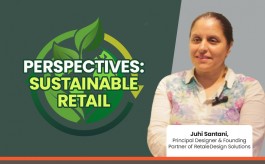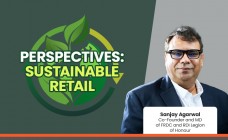‘Smart brands have realized that sustainability is their most powerful competitive weapon’
By Retail4Growth Bureau | June 16, 2025
Indeed, sustainable stores that host upcycling workshops aren't being altruistic—they're being strategic, creating experiential backdrops for their merchandising that Amazon and other online retailers can't replicate, writes Cynthia Hirsch Ortiz, International President - Retail Design Institute, New York, MBH Architects, in this exclusive column for Retail4Growth.

Sustainable store design and visual merchandising isn't about environmental altruism—it's about saving your business. While some retailers are still treating eco-friendly design as a nice-to-have, smart brands have realized that sustainability is their most powerful competitive weapon. Customers are getting better at spotting green-washing, and those recycling bins aren't fooling anyone. Real sustainable design requires genuine commitment that goes much further. When Patagonia builds fixtures from recycled materials, they're not virtue signaling—they're proving their values through action, and that authenticity translates directly into customer loyalty and premium pricing power.
The biggest mistake retailers make is treating sustainability like a cost-cutting exercise while ignoring its potential. Yes, LED lighting saves money, but customers don't care about your utility bills. They care because sustainability and shopping at responsible retailers makes them part of something meaningful. Smart visual merchandisers and store design teams are using sustainable materials as hero elements—cork wall installations that showcase accessories, bamboo fixtures that complement organic product lines, recycled glass displays that catch light beautifully. These aren't just eco-friendly choices; they're design statements that elevate product presentation while reinforcing brand values.
Most retailers focus on hidden operational efficiency while missing the visual impact of sustainable merchandising, but forward-thinking brands understand that Instagram-worthy sustainable displays generate more value than invisible eco-upgrades ever could. Sustainable stores that host upcycling workshops aren't being altruistic—they're being strategic, creating experiential backdrops for their merchandising that Amazon and other online retailers can't replicate. QR codes revealing material origins and real-time energy dashboards aren't tech for tech's sake—they're storytelling tools that add depth to visual presentations.
Here are the facts: sustainable design can be harder and more expensive upfront, but will bring in the customer loyalty needed for a brand’s success. Younger consumers aren't just preferring sustainable brands—they're boycotting unsustainable ones. The retailers winning this transformation are using sustainability as both an innovation catalyst and visual merchandising advantage, understanding that physical stores must offer uniquely compelling experiences. Get this right, and you'll thrive. Miss it, and you'll become a case study in retail that is no longer relevant.

_165_265.jpg)
_165_265.jpg)






Comments